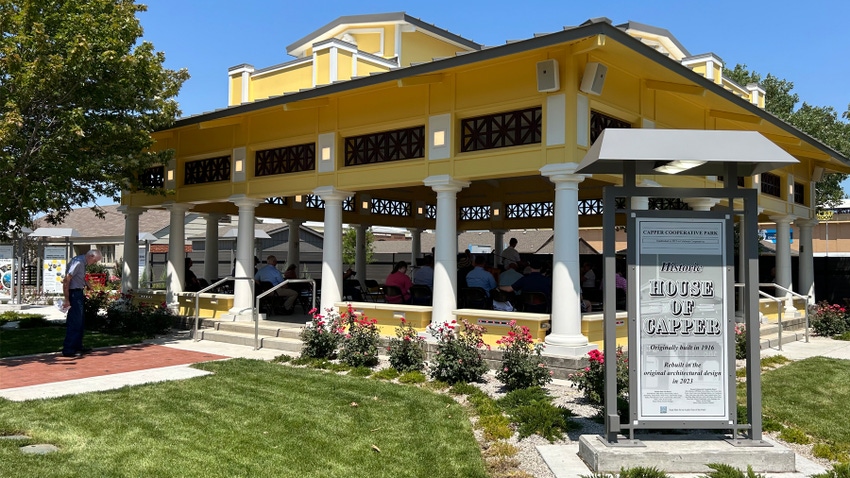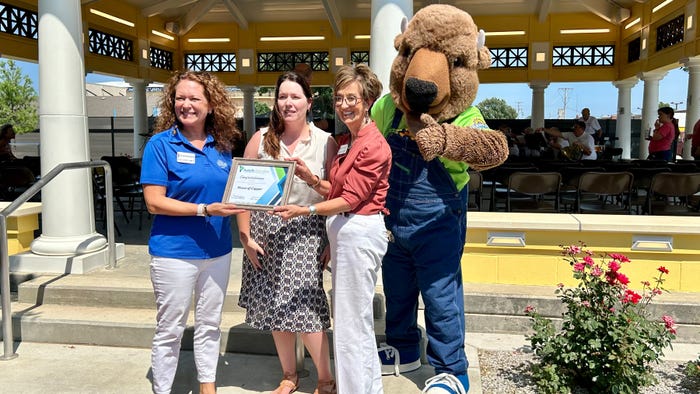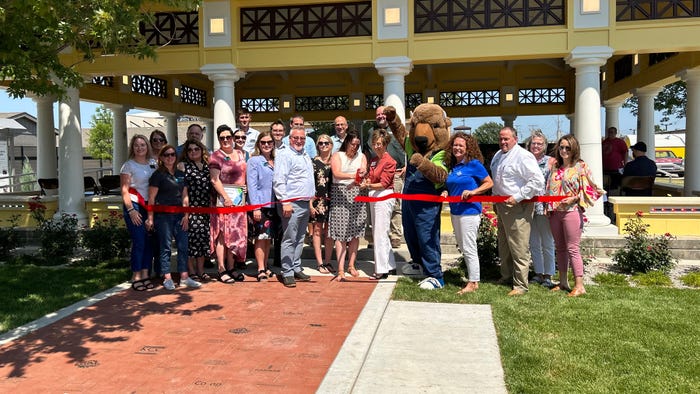
It was a ceremony that would have made Arthur Capper proud.
A group of dignitaries and sponsors gathered on the Kansas State Fairgrounds July 24. Backed by a band playing in the shade of the reconstructed House of Capper, the group officially opened it and the accompanying new Capper Cooperative Park with a snip of the ceremonial scissors.
History renewed
Generations of Kansans are familiar with the House of Capper on the Kansas State Fairgrounds in Hutchinson. The original building was constructed in 1916 with $3,000 from the Capper Publications, in honor of then-Kansas Gov. Arthur Capper, its founder. The original building provided shade, cool water, and public restrooms to fairgoers. And over the years many politicians made campaign stops from its steps. For example, in 1923, then-U.S. Sen. Capper joined then-President Warren G. Harding at the House of Capper, where he spoke to an over-capacity crowd of 13,000.

COOPERATIVE EDUCATION: The Capper Cooperative Park, north of the House of Capper, tells the story of Sen. Arthur Capper’s role in writing the Capper-Volstead Act of 1922. That act paved the way for today’s cooperatives, such as grain co-ops, electrical co-ops and even credit unions.
Mary McCurry, Kansas Fairgrounds Foundation president, said Capper had a philanthropic heart for the state, advocating for children through his Capper Foundation. But it was his political work on behalf of Kansans as the first native-born Kansan to serve as governor of the state and his 30 years in the U.S. Senate that paved the way for so much of the prosperity we enjoy today.
In spring 2021, the House of Capper was deemed structurally unsound, according to the foundation. The roof was in imminent danger of collapse and that yellow caution tape surrounded the building — keeping fairgoers out for their own safety. According to Bryan Schulz, KSF general manager, there wasn’t anything that could be salvaged from the old pavilion; it all had to go.
“It was very important to get this right, though,” he said. “We looked back in history and we were able to make sure that we had the hip, the roof lines right, the colors correct, and all that kind of stuff. It was very important for us to keep this as historical as possible.”
Fortunately, Schaefer Architecture of Wichita was able to find the original blueprints for the House of Capper and refer to historical photos and documents in its design for the new building. Visitors today will see a pavilion that looks nearly identical to the old one, but that also incorporates modern improvements such as lighting and ADA (Americans with Disabilities Act) accessibility.
Educational park
As a U.S. senator, Capper co-authored the Capper-Volstead Act of 1922, which allowed for the legal formation of cooperatives in the United States. It’s perhaps one of his most lasting legacies to the prosperity of the nation.

GROUP EFFORT: The reconstruction of the House of Capper was a collaborative effort among the Kansas State Fair Board, Kansas Fairgrounds Foundation, and the Kansas Cooperative Council. Paula Landoll Smith (left), Fair Board president; Brandi Miller, council president and CEO; and Mary McCurry, foundation president, along with the Kansas State Fair mascot Ike the Bison, mark the occasion.
The foundation created the Capper Project to find funding sources to help rebuild the pavilion as well as educate fairgoers about the role cooperatives play in their lives. Directly adjacent to the House of Capper is the Capper Cooperative Park, a green space with storyboards telling the cooperative story.
The Kansas Cooperative Council pledged $100,000 to the Capper Project, and cooperatives from around the state joined in, eventually raising nearly $700,000 to complete the project. Today, you can see their names on the pillars of the House of Capper — from grain cooperatives to electric cooperatives and more.

RIBBON-CUTTING: Kansas State Fair dignitaries and sponsors, along with Ike the Bison, cut the ribbon to officially open the reconstructed House of Capper on the Kansas State Fairgrounds.
As Brandi Miller, president and CEO of the Kansas Cooperative Council, explained in her remarks, if you are a farmer who markets grain through a cooperative in this state, if you purchase electricity in this state, or if you bank at a credit union — you can thank Arthur Capper and the Capper-Volstead Act. It’s only fitting, she added, that future generations can learn his story at the state’s largest classroom, the Kansas State Fairgrounds.
More fairground improvements debut in 2023
Paula Landoll Smith, Kansas State Fair Board president, and Bryan Schulz, KSF general manager, said there are other fairground improvements that will debut this year at the fair, Sept. 8-17. From new asphalt around the grounds, to repainted buildings, to a new fire station and a new fairgrounds-wide public address system, change is coming to the Kansas State Fair.
In addition, there’s other construction and refurbishment projects in the works.

HOOVES UP: Ike the Bison gives the new facility a big “hooves up.” Go see Ike and the new House of Capper at the 2023 Kansas State Fair, Sept. 8-17, in Hutchinson.
“This year we were hoping to be able to get 4-H Centennial Hall and the Oz Gallery both air-conditioned,” Schulz said. Unfortunately, he said, delays in getting the equipment to the fairgrounds mean that the Oz Gallery will be air-conditioned, but the 4-H Centennial Hall will have to wait until its equipment is delivered.
2023 fairgoers will see a new 18- by 20-foot LED screen on the west side of the grounds that will show sponsorships, as well as daily schedules.
“We’re looking at off-season events, like movies, and when the Kansas City Chiefs make it back to the Super Bowl, we’ll be able to have a Super Bowl party right out on the Midway,” Schulz said.
More recently, the fair board voted in November to remove the 110-year-old, 17-acre dirt racetrack oval at the fairgrounds. The last Hutchinson Grand National Auto Races were held in July, and the track is slated for demolition by the end of 2023, despite local opposition. Plans are already underway to use the footprint for expanded facilities construction, since the fairgrounds are landlocked within the city limits of Hutchinson.
One of the larger construction and renovation projects in the works is the Bison Arena. The arena is one of the oldest buildings on the fairgrounds, constructed in 1937 as a public works project. It was used as the primary 4-H and FFA livestock exhibition space for decades until the new Prairie Pavilion was built in the early 2000s. In 2019, it was also closed to the public for not meeting current fire codes.
According to the Hutchinson News, in 2022 the state of Kansas earmarked $10 million in the fiscal year 2023 budget for renovation of the iconic building into a year-round agricultural education center, with the expectation that the KSF Foundation would match those funds for the full amount of the project.
The plans are to turn the Bison Arena into not only an educational space for school groups to learn about agriculture year-round, but also include a commercial kitchen and the ability to turn it into a community meeting space.
“There are a lot of people who have a lot of memories of the Bison Arena, and it’s important to them to preserve that heritage,” Landoll Smith said. “We’ve gotten some funding from the Legislature, but we also have to come up with some funding — so we’re hoping that people reach out and want to help us preserve this history.”
About the Author(s)
You May Also Like






